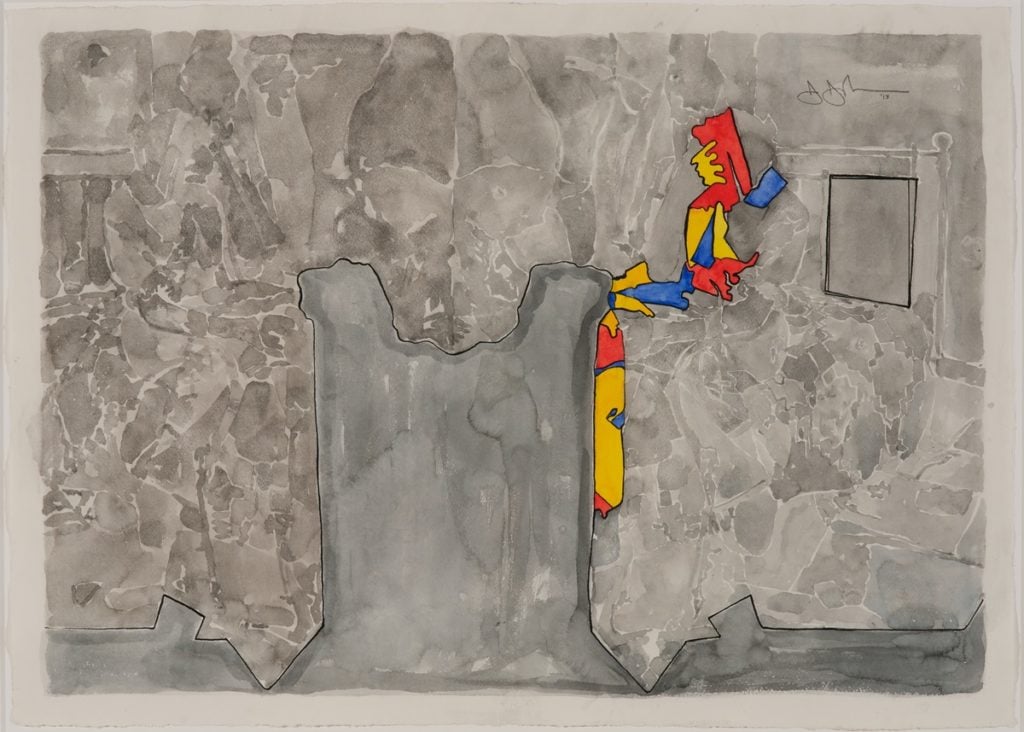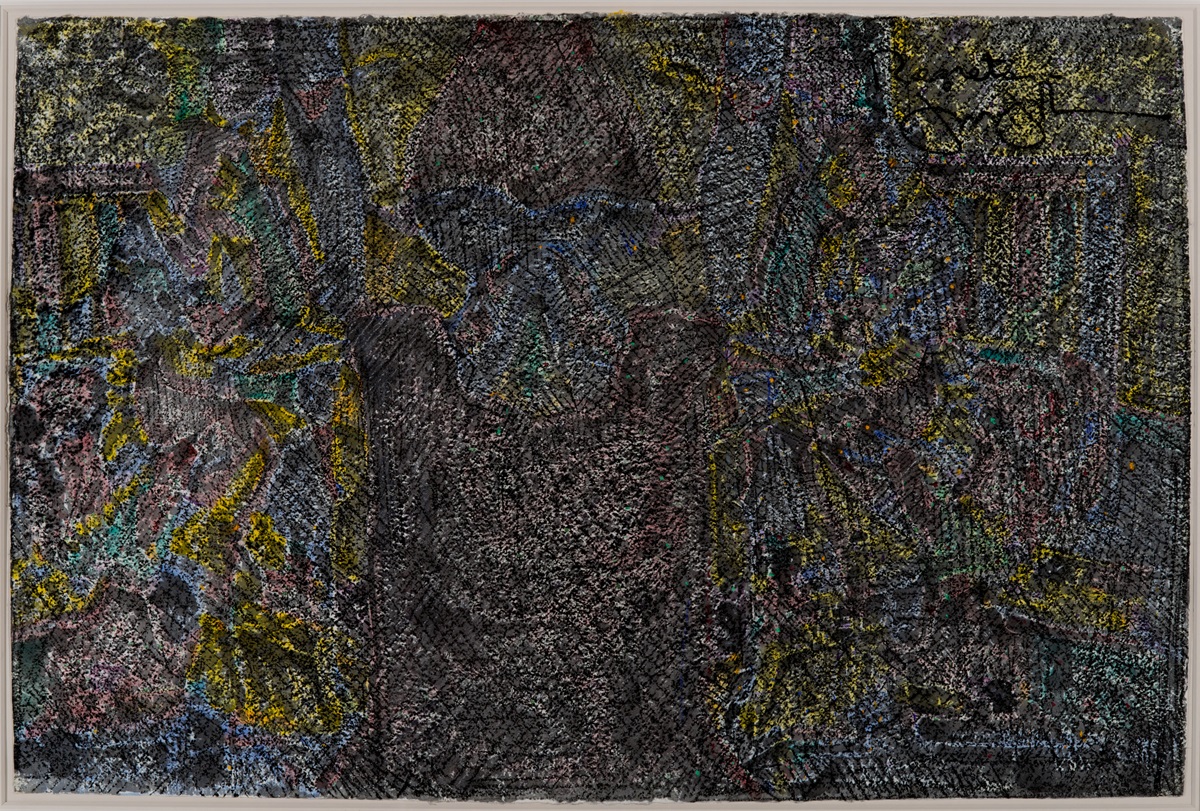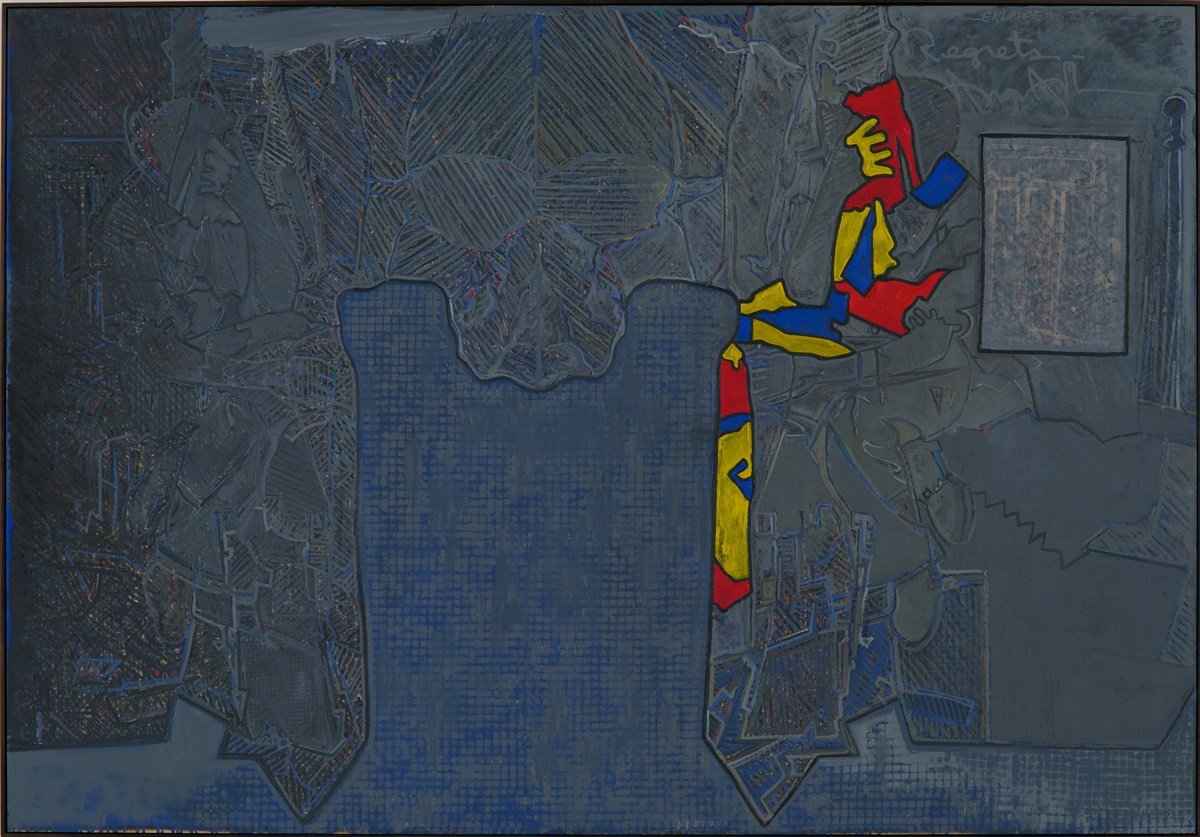Art World
Up Close and Personal with Jasper Johns’s “Regrets” at MoMA
Johns's printmaking work deepens the mystery of his artistic process.

Johns's printmaking work deepens the mystery of his artistic process.

While flipping through a Christie’s London catalogue in 2012, America’s most famous living artist, Jasper Johns, found something that caught his eye. It was a tattered, paint-stained photograph of the British painter Lucian Freud, sitting on a bed, his face hidden by his hand, in a pose of despair or perhaps disgust. The photograph, taken in 1964 by John Deakin, was commissioned by another British artist, Francis Bacon. It was one of the studies that Bacon used to create a triptych in 1969 entitled Three Studies of Lucian Freud that sold this past November at Christie’s New York for $142.4 million, the most expensive painting that ever sold at auction at any time in history.
But none of that interested Johns. What intrigued him was that the photograph was not just a representation of Freud, but was actually an artifact of Bacon’s creative act. The photograph had been ripped and folded back, as if Bacon was trying to physically manipulate the image into what he was thinking about. There were spatters of black and green oil paint across the crumpled surface. It looked like the battered survivor of a violent act.
Those random marks and the incidental outline of a missing piece of the photo were irresistible to Johns, who, like his old friend the late John Cage, viewed them as an unexpected serendipitous encounter—the kind that gets the imagination firing. He immediately seized the moment and, in a flurry of activity, created 23 works in a year and a half. The resulting paintings, drawings, and prints, as well as the plates used to make the prints, (and nine unrelated monotypes) are on view at New York’s Museum of Modern Art until September 1. The exhibit, entitled “Regrets,” is organized by Christophe Cherix, the museum’s chief curator of prints and drawings, and Ann Temkin, the chief curator of painting and sculpture at MoMA.

Jasper Johns, Study for Regrets, 2012. Acrylic, photocopy collage, colored pencil, ink and watercolor on paper. Collection the artist. Courtesy The Museum of Modern Art, New York.
The wily 83-year-old Johns offers his usual array of visual conundrums and puzzles, including the red herring of the exhibit’s title, which, viewers are informed, has nothing to do with the artist’s emotional state. “Regrets” refers to a rubber stamp Johns used to decline invitations. Johns used it to stamp his first drawing, Study for Regrets, and then later on had Bill Goldston, his printer at Universal Limited Art Editions (ULAE), enlarge the text as a screenprint which he inserted into the paintings and some but not all of the drawings in the show. Such markings are like catnip for Johns lovers, who see these details as an invitation—no, a challenge—to ferret out visual clues that have mysteriously disappeared and reemerged in the artist’s paintings over the past 60 years.
Christophe Cherix says the chronology of the works in the show provides a key to Johns’s creative decisions with regard to the use of how the Freud image would evolve, while the artist moved from painting to drawing to printmaking and back again. The first work inspired by the photograph was Study for Regrets, 2012, an acrylic, photocopy collage with colored pencil, ink and watercolor on paper. The piece is curiously bifurcated—the photograph of Freud, including the paint splotches, crumpled surface and folds is rendered on the right side in a riotously colored palette reminiscent of Peter Max; the left side, a mirror image drawn on top of a photocopy, is a more somber affair, with the myriad shades of grey the artists is more often associated with.

Jasper Johns, Regrets, 2013. Watercolor, charcoal, and pastel on paper. The Museum of Modern Art, New York. Promised gift of Marie-Josée and Henry R. Kravis. Art © Jasper Johns/Licensed by VAGA, New York, NY. Photo: Jerry Thompson.
Without knowing the source material, Regrets, 2013, a watercolor, charcoal, and pastel with confetti-like specks of color just barely visible from underneath a thick coating of charcoal, would be unreadable. But by making the decision to obscure the color, Johns creates the strategy that will define the second painting in the show. Color would be a distraction—he decides to eliminate four of the plates for his first etching, which will now be black and white as the different states prior to the final print reveal. His first oil painting, Regrets, 2013, is subsequently changed into a monochromatic work (although there is still color underneath if you look carefully) with a jigsaw puzzle-like surface reminiscent of the artist’s early Map paintings. The outline of the missing photo fragment and its mirror image have become conjoined to create the central motif, looming like some kind of monolith, paired on each side with the figure on the bed, just barely visible. Rising over the monolith appears to be the outline of a skull. But the artist claims this is simply one reading of the image, as is the meaning of the word “Regrets” and the artist’s signature, as well as directions to enlarge as a silkscreen on the upper right corner of the painting.
At a standstill with his second print, the artist put aside his printmaking and began making india ink drawings on plastic. The pooling of the ink on the plastic surface made it very difficult to control, but it also led to visual solutions for the artist’s second print. A window or square developed in the upper right corner taking the place of the “Regrets” stamp. Other new elements were introduced into the second monochromatic Regrets painting, include a tiny band of color unfurling along the outline of the Freud figure.
When Johns returned to complete the second print, the tombstone and skull images remain but the figure is now completely obscured visible only in shimmering traces below what appears to be a glowing square or perhaps an open window. Is the artist grappling with his own mortality—or drawing his own escape hatch?
On one of the early drawings for the series, Johns has written on the bottom, “Goya? Bats? Dreams?” The artist was referring to the famous Francisco Goya 1790s etching from Los Caprichos (Caprices) “The Sleep of Reason Produces Monsters.” In it, the artist sleeps while being besieged by an ominous swarm of bats and owls. Is Johns referring to his own betrayal by his former assistant James Meyer, who stole 22 works from Johns’ studio, while he was blissfully unaware (asleep?). Or is Johns simply reminding us, that over his long career he has remained steadfast in his commitment to keep creating, despite all the folly and distractions that bedevil us all.

Jasper Johns (American, born 1930). Regrets. 2013. Oil on canvas. 50 × 72″ (127 × 182.9 cm). Art © Jasper Johns/Licensed by VAGA, New York, NY. Photo: Jerry Thompson.